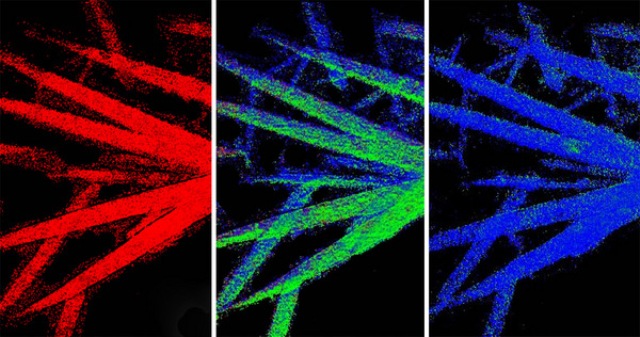Apr 21 2015
Researchers from University of Wisconsin-Madison and Brookhaven National Laboratory have formulated an innovative X-ray imaging method to visualize and analyze electrochemical reactions generated within lithium-ion rechargeable batteries which contains iron fluoride, a new kind of material. This breakthrough project is likely to enhance the way energy is stored in numerous products, ranging from portable electronics to electric microgrids.
 Chemical phase map showing how the electrochemical discharge of iron fluoride microwires proceeded from 0 percent discharge (left), to 50 percent (middle), to 95 percent. Image: Linsen Li
Chemical phase map showing how the electrochemical discharge of iron fluoride microwires proceeded from 0 percent discharge (left), to 50 percent (middle), to 95 percent. Image: Linsen Li
"Iron fluoride has the potential to triple the amount of energy a conventional lithium-ion battery can store," says Song Jin, a UW-Madison professor of chemistry and Wisconsin Energy Institute affiliate. "However, we have yet to tap its true potential."
Jin, along with graduate student Linsen Li and other teammates, conducted several experiments using an advanced transmission X-ray microscope at the National Synchrotron Light Source at Brookhaven. Here, during battery cycling, the team gathered chemical maps from real coin cell batteries containing iron fluoride to establish a high level of performance.
"In the past, we weren't able to truly understand what is happening to iron fluoride during battery reactions because other battery components were getting in the way of getting a precise image," says Li.
Li was successful in precisely visualizing and measuring, at the nanoscale, the chemical alterations that iron fluoride goes through, so as to store and release energy by taking into consideration background signals which may distort the image.
Up until now, scientists have had to face two issues regarding usage of iron fluoride in rechargeable lithium ion batteries. The first issue was that the batteries are unable to recharge properly in their current form.
"This would be like your smart phone only charging half as much the first time, and even less thereafter," says Li. "Consumers would rather have a battery that charges consistently through hundreds of charges."
By analyzing the alterations in iron fluoride in the batteries at the nanoscale, the researchers were able to identify each separate reaction, resulting in clear reasons for capacity decay using the newly formulated X-ray imaging method.
"In analyzing the X-ray data on this level, we were able to track the electrochemical reactions with far more accuracy than previous methods, and determined that iron fluoride performs better when it has a porous microstructure," says Li.
The second issue with iron fluoride filled batteries was that they were unable to discharge the same amount of energy as they absorbed, thus minimizing energy efficiency. The current research, however, provides some pointers as to how to solve these issues. Going forward, Jin and Li will be working on concrete solutions by conducting more experiments.
One of the conclusions that can be drawn from this research is using portable electronic gadgets for longer before charging. Jin perceives that their research can be applied for wider range of applications.
"If we can maximize the cycling performance and efficiency of these low-cost and abundant iron fluoride lithium ion battery materials, we could advance large-scale renewable energy storage technologies for electric cars and microgrids," he says.
Additionally, Jin also feels that their X-ray imaging method will aid in future studies of other technologically significant solid-state transformations, and help to enhance techniques for creation of inorganic ceramics and thin-film solar cells.
The experiments were performed with the help of Yu-chen Karen Chen-Wiegart, Feng Wang, Jun Wang and their co-workers at Beamline X8C, National Synchrotron Light Source, Brookhaven National Laboratory, and supported by the U.S. Department of Energy Basic Energy Sciences and a seed grant from the Wisconsin Energy Institute. The synthesis of the battery materials in Jin's lab was supported by National Science Foundation Division of Materials Research.
The research findings have been published in the journal Nature Communications.